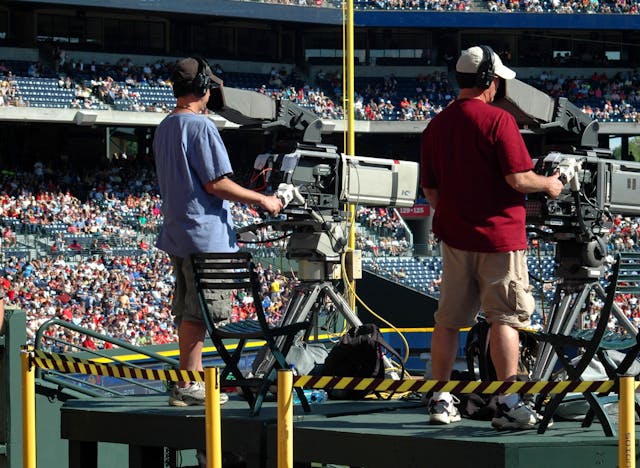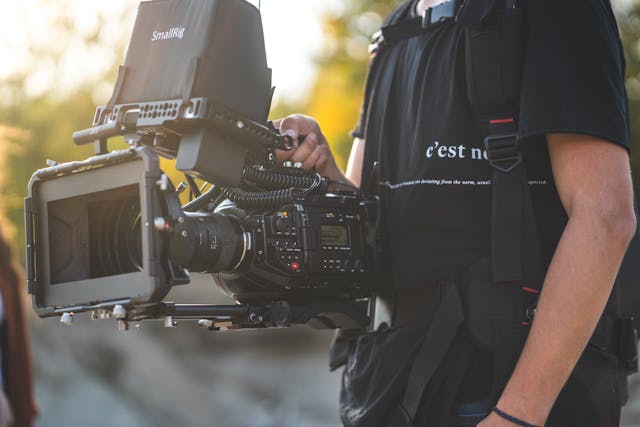AV Specialist Interview Questions with Answers

As the demand for audiovisual (AV) specialists continues to grow, hiring managers are tasked with identifying candidates who are not only technically proficient but also capable of adapting to the dynamic nature of the industry. Whether you are a hiring manager looking to refine your interview process or a job seeker preparing to showcase your skills, these top technical interview questions for AV specialists can guide you. If hiring managers need assistance in finding the right talent, consider reaching out to Tier2Tek Staffing for expert help in staffing.
What is the signal flow in an AV system?
Answer: Signal flow is the path that audio and video signals follow from their sources to their outputs. It’s crucial for setting up and troubleshooting AV systems.
How do you troubleshoot audio feedback in a sound system?
Answer: To reduce audio feedback, adjust the mic and speaker placement, reduce mic gain, and use feedback suppressors or equalization to eliminate problem frequencies.
Can you explain the difference between HDMI and SDI cables?
Answer: HDMI cables are used for consumer devices to transmit HD audio and video, while SDI cables are used in professional settings for long-distance, high-quality video transmission.
What is a codec and why is it important in AV systems?
Answer: A codec compresses and decompresses digital media to facilitate efficient transmission and storage, crucial for maintaining quality in AV systems.
Describe how you would set up a video conference in a multi-location company.
Answer: Ensure compatible AV equipment and internet connectivity across all sites, select a reliable conferencing platform, and perform a test run to troubleshoot issues beforehand.
What are the key considerations when designing an AV system for a new building?
Answer: Consider the purpose and AV needs of each space, acoustics, lighting, user interfaces, and ensure the system is scalable and integrates well with other building systems.
How do you ensure AV equipment is compatible with various digital formats?
Answer: Keep up-to-date with AV standards, select versatile and reputable equipment, and use adaptable interfaces and converters.
How would you handle a situation where AV equipment fails during a live event?
Answer: Quickly diagnose the issue, have backup equipment ready, and switch to the backup system with minimal disruption.
What are the best practices for maintaining AV equipment?
Answer: Regularly clean and inspect equipment, update software and firmware, and schedule preventive maintenance to extend lifespan and performance.
Explain the importance of AV integration in smart buildings.
Answer: AV integration in smart buildings enhances user experience, improves communication efficiency, and contributes to energy management and other building automation systems.
What factors do you consider when selecting microphones for different environments?
Answer: Consider the acoustics, ambient noise levels, the purpose of the audio capture, and the microphone’s directional characteristics to choose the right type for each environment.
How do you configure a surround sound setup?
Answer: Align speakers according to the environment’s layout, adjust the audio processor for optimal channel output, and calibrate speaker levels to create an immersive sound experience.
What is the role of a matrix switcher in an AV system?
Answer: A matrix switcher routes multiple audio/video sources to different outputs, allowing for flexible content distribution and management across various display devices.
How do you optimize video quality over a low-bandwidth connection?
Answer: Use compression codecs designed for low bandwidth, lower the resolution or frame rate, and prioritize important video streams to maintain the best possible quality.
Explain the difference between analog and digital AV systems.
Answer: Analog systems transmit continuous signals with potential quality loss over distance, while digital systems use discrete signals that maintain quality over long distances and are easier to integrate with modern technology.
What are the safety protocols you follow when installing AV equipment?
Answer: Adhere to electrical safety standards, use appropriate mounting equipment and techniques, and ensure all installations are secure and compliant with local safety regulations.
Describe your experience with AV control systems like Crestron or AMX.
Answer: Discuss familiarity with programming, configuring, and troubleshooting these systems to manage and automate AV equipment, highlighting any specific projects or challenges overcome.
How would you explain the benefits of a new AV technology to a non-technical audience?
Answer: Use simple terms and practical examples to illustrate how the technology improves efficiency, enhances media quality, or solves specific problems in their daily operations.
What methods do you use to stay updated with advancements in AV technology?
Answer: Mention attending industry conferences, participating in professional workshops, subscribing to AV technology publications, and engaging with online forums and communities.
Can you discuss a project where you integrated AV technology with other IT or building systems?
Answer: Outline a scenario where AV systems were integrated with IT network systems, building management systems, or other technologies, describing the benefits and any challenges faced.
How do you ensure synchronization between audio and video streams in live events?
Answer: Use timecode generators and sync boxes to ensure all devices operate on the same clock, and adjust delays in the AV processor to match audio and video timing.
What considerations are important when setting up AV for outdoor events?
Answer: Factor in weather conditions, power supply issues, visibility in natural lighting, and effective sound projection, ensuring all equipment is suitable for outdoor use.
How do you manage wireless frequency interference in AV setups?
Answer: Scan for active frequencies to avoid interference, use frequency coordination software, and deploy directional antennas to enhance signal strength and reduce noise.
What steps do you take for effective cable management in an AV installation?
Answer: Organize cables by length and function, use cable trays and conduits, label everything clearly, and ensure all cables meet safety and performance standards.
How do you determine the right projection size and brightness for different venues?
Answer: Calculate the screen size based on the distance to the furthest viewer, consider ambient light levels to choose projector brightness, and ensure the content is visible from all angles.
Explain the process of calibrating a sound system in a large venue.
Answer: Use audio analyzers to measure sound levels across different points, adjust speaker angles and outputs for even coverage, and tune equalizers to optimize sound clarity and reduce echoes.
What challenges have you faced in AV installations and how did you overcome them?
Answer: Share specific examples of logistical, technical, or coordination challenges, detailing the solutions implemented to solve those issues effectively.
How do you handle software updates and compatibility in integrated AV systems?
Answer: Regularly check for updates from manufacturers, test updates in a controlled environment before full deployment, and ensure compatibility with existing components.
Can you describe a situation where you had to innovate to meet a client’s AV needs?
Answer: Provide an example of a custom solution or creative use of technology that addressed a unique challenge or significantly improved the client’s experience.
What are your practices for ensuring AV system security, particularly in public or shared spaces?
Answer: Implement network security protocols, use encrypted connections, restrict access to control systems, and regularly audit the security measures in place.
Common Technologies Used by AV Specialists

AV specialists utilize a range of technologies to manage and optimize audiovisual systems effectively. Here are some of the most commonly used:
- Audio and Video Conferencing Software: Platforms like Zoom, Microsoft Teams, and Cisco Webex are essential for setting up virtual meetings and live streaming events.
- Digital Audio Workstations (DAW): Software such as Pro Tools, Ableton Live, and Logic Pro X are used for editing, recording, and producing audio.
- Video Editing Software: Tools like Adobe Premiere Pro, Final Cut Pro, and DaVinci Resolve are crucial for video production and editing.
- Control Systems: Systems like Crestron, Extron, and AMX help AV specialists manage multiple AV devices from a single interface.
- Sound Reinforcement Systems: This includes mixers, microphones, speakers, and amplifiers, essential for live sound management and public address systems.
- Projection and Display Technology: Including high-definition projectors, LED walls, and interactive displays for various presentation and entertainment needs.
- Networking Equipment: Routers, switches, and wireless access points are used to manage data flow across AV and IT networks.
- Codec Technology: Hardware and software codecs are crucial for compressing and decompressing video and audio streams efficiently.
- Signal Processors: Such as equalizers, compressors, and DSPs (Digital Signal Processors) to enhance and manage audio quality.
- Cabling and Connectivity Solutions: HDMI, SDI, and fiber optic cables are key for connecting and transmitting AV signals reliably.
Key Expertise of AV Specialists
AV specialists possess a broad range of expertise essential for designing, implementing, and managing sophisticated audiovisual systems. Here’s a breakdown of their core skills:
- System Design and Integration: Expertise in designing and integrating complex AV systems tailored to specific environments and user requirements.
- Audio and Video Engineering: Profound knowledge in configuring and operating various audio and video equipment, ensuring optimal sound and image quality.
- Network Management: Skills in managing networked AV systems, including IP configurations, bandwidth management, and network security protocols.
- Troubleshooting and Problem-Solving: Ability to quickly diagnose and resolve technical issues that arise with AV equipment and software.
- Project Management: Proficiency in overseeing AV projects from conception through completion, ensuring they meet all technical specifications and deadlines.
- Client Relations and Communication: Strong communication skills to effectively collaborate with clients, team members, and other stakeholders.
- Software Proficiency: Familiarity with industry-standard software for audio mixing, video editing, and system control.
- Training and Documentation: Skills in training end-users on new systems and creating detailed documentation to support system maintenance and upgrades.
- Compliance and Standards: Understanding of relevant industry standards and compliance requirements to ensure safety and high-quality AV installations.
- Creative Problem-Solving: The ability to come up with innovative solutions for unique AV challenges, often under tight constraints.
Need to Hire AV Specialists?

If you’re looking to recruit top-tier AV specialists, Tier2Tek Staffing offers comprehensive support to find the best talent suited for your technical and creative needs. Our expertise ensures a seamless hiring process, specifically tailored to the AV industry.
